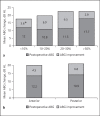The Long-Term Stability of Fat-Graft Myringoplasty in the Closure of Tympanic Membrane Perforations and Hearing Restoration
- PMID: 33341797
- PMCID: PMC8117378
- DOI: 10.1159/000512084
The Long-Term Stability of Fat-Graft Myringoplasty in the Closure of Tympanic Membrane Perforations and Hearing Restoration
Abstract
Background/aims: This study was conducted to evaluate the long-term stability of fat-graft myringoplasty (FGM) for chronic tympanic membrane perforations, analyzing the perforation closure rate and re-gained hearing outcome with respect to the size and location of the perforations.
Methods: Between August 2007 and June 2018, a total of 193 patients who underwent FGM due to chronic tympanic membrane perforation at a tertiary referral center were enrolled and analyzed.
Results: The mean follow-up was 14.6 months (range 6-39). The complete perforation closure rate after FGM was 89.6%, with no statistical difference among the perforation size groups. The mean postoperative air-bone gap (ABG) was 11.0 dB and mean ABG improvement was 4.9 dB.
Conclusion: Our FGM technique had a favorable tympanic closure rate for small to large perforations, and yielded relatively good hearing improvement in the mid-size perforation cases over long-term follow-up periods. According to the topographic evaluation of FGM, this procedure resulted in a reliable perforation closure rate and audiological results regardless of the perforation site.
Keywords: Autologous fat; Ear surgery; Myringoplasty.
© 2020 The Author(s) Published by S. Karger AG, Basel.
Conflict of interest statement
All authors approved this manuscript, and there are no conflicts of interest to report.
Figures



References
-
- Lindeman P, Edström S, Granström G, Jacobsson S, von Sydow C, Westin T, et al. Acute traumatic tympanic membrane perforations. Cover or observe? Arch Otolaryngol Head Neck Surg. 1987 Dec;113((12)):1285–7. - PubMed
-
- Liew L, Daudia A, Narula AA. Synchronous fat plug myringoplasty and tympanostomy tube removal in the management of refractory otorrhoea in younger patients. Int J Pediatr Otorhinolaryngol. 2002 Dec;66((3)):291–6. - PubMed
-
- Sckolnick JS, Mantle B, Li J, Chi DH. Pediatric myringoplasty: factors that affect success-a retrospective study. Laryngoscope. 2008 Apr;118((4)):723–9. - PubMed
-
- Ringenberg JC. Fat graft tympanoplasty. Laryngoscope. 1962 Feb;72((2)):188–92. - PubMed
-
- Fiorino F, Barbieri F. Fat graft myringoplasty after unsuccessful tympanic membrane repair. Eur Arch Otorhinolaryngol. 2007 Oct;264((10)):1125–8. - PubMed
MeSH terms
LinkOut - more resources
Full Text Sources
Miscellaneous

